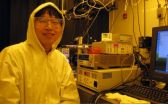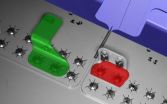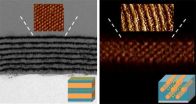(Press-News.org) This press release is available in German.
Optical atomic clocks measure time with unprecedented accuracy. However, it is the ability to compare clocks with one another that makes them applicable for high-precision tests in fundamental theory, from cosmology all the way to quantum physics. A clock comparison, i.e. a comparison of their optical frequencies, proved to be challenging so far as the few existing optical clocks around the world are not readily portable due to their complex nature. A team of researchers from the Physikalisch-TechnischeBundesanstalt (PTB) in Braunschweig and from the Laser Spectroscopy Division at the Max Planck Institute of Quantum Optics (MPQ) in Garching have now demonstrated an optical frequency transfer with high stability through a standard telecommunication optical fiber network (Science, April 27, 2012). The optical fiber connecting the two institutes was installed below ground and had a total length of 920 kilometres. This demonstration enables the ability to compare optical clocks located far apart from each other and to transmit their stability to distant laboratories where the signals can be used for high precision experiments. At first, fundamental research will benefit from this, e.g. in the precise determination of natural constants, tests of the validity of Einstein's theory of General Relativity or for predictions in quantum electrodynamics.
In an atomic clock the frequency that an atom emits when changing from one energy level to another defines the unit of time. The unit "second" is the interval occupied by 9,192,631,770 cycles of the microwave radiation corresponding to a transition of the cesium-133 isotope. The generation and dissemination of the second is statutory and in Germany the duty of the PTB. Optical atomic clocks use a frequency that is about 100,000 times higher compared to microwave clocks and thus slice time into much finer intervals. The latest generation of optical atomic clocks differs only in the 18th decimal place – that corresponds to one second in a time period of the age of the universe.
The researchers asked themselves the question of how well one can transfer optical frequencies over long distances. Well established techniques with the help of satellites reach a stability of 15 decimal places. While this is sufficient for microwave signals it is inadequate to exploit the full potential of optical atomic clocks. During the last years the MPQ/PTB researchers therefore investigated how to transmit an optical frequency through optical fibers. They were supported by the Cluster of Excellence QUEST at Leibniz Universität Hannover, the European Space Agency (ESA), the Deutsches Forschungsnetzwerk DFN as well as GasLine, a German consortium of gas distribution companies.
In the project described here the researchers feed light from a highly stable laser with a wavelength around 1.5 micrometers (near infrared) in the optical fiber connecting the laboratories at MPQ and PTB. The optical fiber is commonly used in telecommunication and has an attenuation minimum for light in the near infrared. However, to transmit a signal over a distance of almost 1,000 kilometers it has to be refreshed periodically. For this, novel optical amplifier units have been developed and installed along the entire path of the optical fiber.
Another problem to overcome is the falsification of the sent laser frequency due to mechanical, acoustic or thermal disturbances that originate from temperature fluctuations, traffic or construction work close to the optical fiber. New techniques allow for detection and compensation of these disturbances in such a way, that the entire 920 kilometers of optical fiber between Garching and Braunschweig is changing its optical length by less than one atomic diameter in one second. Hence, the delivered frequency of 194,353 Gigahertz at the remote laboratory differs by less than one ten thousandth from the fed frequency. To put the frequency transfer to the test, the researchers of the laser spectroscopy division used the signal from PTB's primary cesium fountain clock for the spectroscopy of hydrogen at MPQ. By means of a frequency comb, this signal is compared to the optical phase of the transfer laser. They achieved a significantly higher accuracy as would have been possible with satellite-based frequency transfer.
Optical frequencies can now be disseminated with a quality that was only available locally at metrology institutes so far. The use of optical fiber infrastructure that the national research networks provide already today will in future allow for the connection of optical atomic clocks pan-European. In the same way as it is state-of-the-art that conventional alarm or station clocks receive the "correct time" from the PTB via the long-wave transmitter DCF77, the dissemination of an optical reference via optical fibers for the determination of wavelengths or frequencies of optical radiation will find wide application in research and industry.
INFORMATION:
Original publication:
K. Predehl, G. Grosche, S.M.F. Raupach, S. Droste, O. Terra, J. Alnis, Th. Legero, T.W. Hänsch, Th. Udem, R. Holzwarth, and H. Schnatz
A 920 km Optical Fiber Link for Frequency Metrology at the 19th Decimal Place.
Science, April 27, 2012
Contact:
Dr. Harald Schnatz, PTB Department Quantum Optics and Unit of Length,
Phone: +49 531 592-4300, E-mail: harald.schnatz@ptb.de
Dr. Gesine Grosche, PTB Department Quantum Optics and Unit of Length,
Phone: +49 531 592 -4318, E-Mail: Gesine.Grosche@ptb.de
Katharina Predehl, Max Planck Institute of Quantum Optics, Hans-Kopfermann-Straße 1,
85748 Garching, Phone: +49 89 32905-295, E-mail: katharina.predehl@mpq.mpg.de
Dr. Ronald Holzwarth, Max Planck Institute of Quantum Optics, Hans-Kopfermann-Straße 1
85748 Garching, Phone: +49 89 32905-262, E-mail: ronald.holzwarth@mpq.mpg.de
Atomic clock comparison via data highways
In future, optical fibers could connect all optical atomic clocks within Europe – a milestone for various users of optical frequencies in research and industry
2012-04-30
ELSE PRESS RELEASES FROM THIS DATE:
Global prices of pollination-dependent products such as coffee could rise in the long term
2012-04-30
This press release is available in German.
Leipzig/Dresden/Freiburg. In recent years the economic value of pollination-dependent crops has substantially increased around the world. As a team of researchers from the Helmholtz Centre for Environmental Research (UFZ), the Technical University of Dresden and the University of Freiburg headed by the UFZ wrote in an article entitled "Spatial and temporal trends of global pollination benefit" in the open-access journal PLoS ONE the value of ecological pollination services was around 200 billion US dollars in 1993 and rose ...
New drug to tackle fat problems
2012-04-30
Medical researchers at the University of Sheffield have defined the structure of a key part of the human obesity receptor- an essential factor in the regulation of body fat- which could help provide new treatments for the complications of obesity and anorexia.
This major advance in research, published in the journal Structure, will greatly enhance the ability to generate drugs which can both block and stimulate the receptor for the obesity hormone leptin. This could have life-changing effects on people suffering from the complications of obesity and malnutrition.
Researchers ...
Blood samples show deadly frog fungus at work in the wild
2012-04-30
The fungal infection that killed a record number of amphibians worldwide leads to deadly dehydration in frogs in the wild, according to results of a new study.
High levels of an aquatic, chytrid fungus called Batrachochytrium dendrobatidis (Bd) disrupt fluid and electrolyte balance in wild frogs, the scientists say, severely depleting the frogs' sodium and potassium levels and causing cardiac arrest and death.
Their findings confirm what researchers have seen in carefully controlled lab experiments with the fungus, but San Francisco State University biologist Vance ...
Can nature's beauty lift citizens from poverty?
2012-04-30
Using nature's beauty as a tourist draw can boost conservation in China's valued panda preserves, but it isn't an automatic ticket out of poverty for the humans who live there, a unique long-term study shows.
Often those who benefit most from nature-based tourism are people who already have resources. The truly impoverished have a harder time breaking into the tourism business, according to the paper, "Drivers and Socioeconomic Impacts of Tourism Participation in Protected Areas," published in the April 25 edition of PLoS One.
The study looks at nearly a decade of burgeoning ...
Folding light: Wrinkles and twists boost power from solar panels
2012-04-30
Taking their cue from the humble leaf, researchers have used microscopic folds on the surface of photovoltaic material to significantly increase the power output of flexible, low-cost solar cells.
The team, led by scientists from Princeton University, reported online April 22 in the journal Nature Photonics that the folds resulted in a 47 percent increase in electricity generation. Yueh-Lin (Lynn) Loo, the principal investigator, said the finely calibrated folds on the surface of the panels channel light waves and increase the photovoltaic material's exposure to light.
"On ...
NYUCN's Dr. Laura Wagner: Study finds accreditation improves safety culture at nursing homes
2012-04-30
Accredited nursing homes report a stronger resident safety culture than nonaccredited facilities, according to a new study published in the May 2012 issue of The Joint Commission Journal on Quality and Patient Safety.
The study shows that senior managers at more than 4,000 facilities across the U.S. identify Joint Commission accreditation as a positive influence on patient safety issues such as staffing, teamwork, training, nonpunitive responses to mistakes, and communication openness. The findings that accreditation stimulates positive changes in safety-related organizational ...
Slow-growing babies more likely in normal-weight women; Less common in obese pregnancies
2012-04-30
Obesity during pregnancy puts women at higher risk of a multitude of challenges. But, according to a new study presented earlier this month at the American Institute of Ultrasound in Medicine annual convention, fetal growth restriction, or the poor growth of a baby while in the mother's womb, is not one of them. In fact, study authors from the University of Rochester Medical Center found that the incidence of fetal growth restriction was lower in obese women when compared to non-obese women.
Researchers, led by senior study author and high-risk pregnancy expert Loralei ...
Assembly errors quickly identified
2012-04-30
Today's cars are increasingly custom-built. One customer might want electric windows, heated door mirrors and steering-wheel-mounted stereo controls, while another is satisfied with the minimum basic equipment. The situation with aircraft is no different: each airline is looking for different interior finishes – and lighting, ventilation, seating and monitors are different from one company to the next. Yet the customer's freedom is the manufacturer's challenge: because individual parts and mountings have to be installed in different locations along the fuselage, automated ...
Golden potential for gold thin films
2012-04-30
Scientists with the Lawrence Berkeley National Laboratory (Berkeley Lab) and the University of California (UC) Berkeley have directed the first self-assembly of nanoparticles into device-ready materials. Through a relatively easy and inexpensive technique based on blending nanoparticles with block co-polymer supramolecules, the researchers produced multiple-layers of thin films from highly ordered one-, two- and three-dimensional arrays of gold nanoparticles. Thin films such as these have potential applications for a wide range of fields, including computer memory storage, ...
New graphene-based material could revolutionize electronics industry
2012-04-30
The most transparent, lightweight and flexible material ever for conducting electricity has been invented by a team from the University of Exeter. Called GraphExeter, the material could revolutionise the creation of wearable electronic devices, such as clothing containing computers, phones and MP3 players.
GraphExeter could also be used for the creation of 'smart' mirrors or windows, with computerised interactive features. Since this material is also transparent over a wide light spectrum, it could enhance by more than 30% the efficiency of solar panels.
Adapted from ...
LAST 30 PRESS RELEASES:
Low daily alcohol intake linked to 50% heightened mouth cancer risk in India
American Meteorological Society announces Rick Spinrad as 2026 President-Elect
Biomass-based carbon capture spotlighted in newly released global climate webinar recording
Illuminating invisible nano pollutants: advanced bioimaging tracks the full journey of emerging nanoscale contaminants in living systems
How does age affect recovery from spinal cord injury?
Novel AI tool offers prognosis for patients with head and neck cancer
Fathers’ microplastic exposure tied to their children’s metabolic problems
Research validates laboratory model for studying high-grade serous ovarian cancer
SIR 2026 delivers transformative breakthroughs in minimally invasive medicine to improve patient care
Stem Cell Reports most downloaded papers of 2025 highlight the breadth and impact of stem cell research
Oxford-led study estimates NHS spends around 3% of its primary and secondary care budget on the health impacts of heat and cold in England
A researcher’s long quest leads to a smart composite breakthrough
Urban wild bees act as “microbial sensors” of city health.
New study finds where you live affects recovery after a hip fracture
Forecasting the impact of fully automated vehicle adoption on US road traffic injuries
Alcohol-related hospitalizations from 2016 to 2022
Semaglutide and hospitalizations in patients with obesity and established cardiovascular disease
Researchers ‘listen in’ to embryo-mother interactions during implantation using a culture system replicating the womb lining
How changing your diet could help save the world
How to make AI truly scalable and reliable for real-time traffic assignment?
Beyond fragmented markets: A new framework for efficient and stable ride-pooling
Can shape priors make road perception more reliable for autonomous driving?
AI tracks nearly 100 years of aging research, revealing key trends and gaps
Innovative techniques enable Italy’s first imaging of individual trapped atoms
KIER successfully develops Korea-made “calibration thermoelectric module” for measuring thermoelectric device performance
Diversifying US Midwest farming for stability and resilience
Emphasizing immigrants’ deservingness shifts attitudes
Japanese eels, climate change, and river temperature
Pusan National University researchers discover faster, smarter heat treatment for lightweight magnesium metals
China’s 2024 Gastroenterology Report: marked progress in endoscopy quality and disease management
[Press-News.org] Atomic clock comparison via data highwaysIn future, optical fibers could connect all optical atomic clocks within Europe – a milestone for various users of optical frequencies in research and industry






